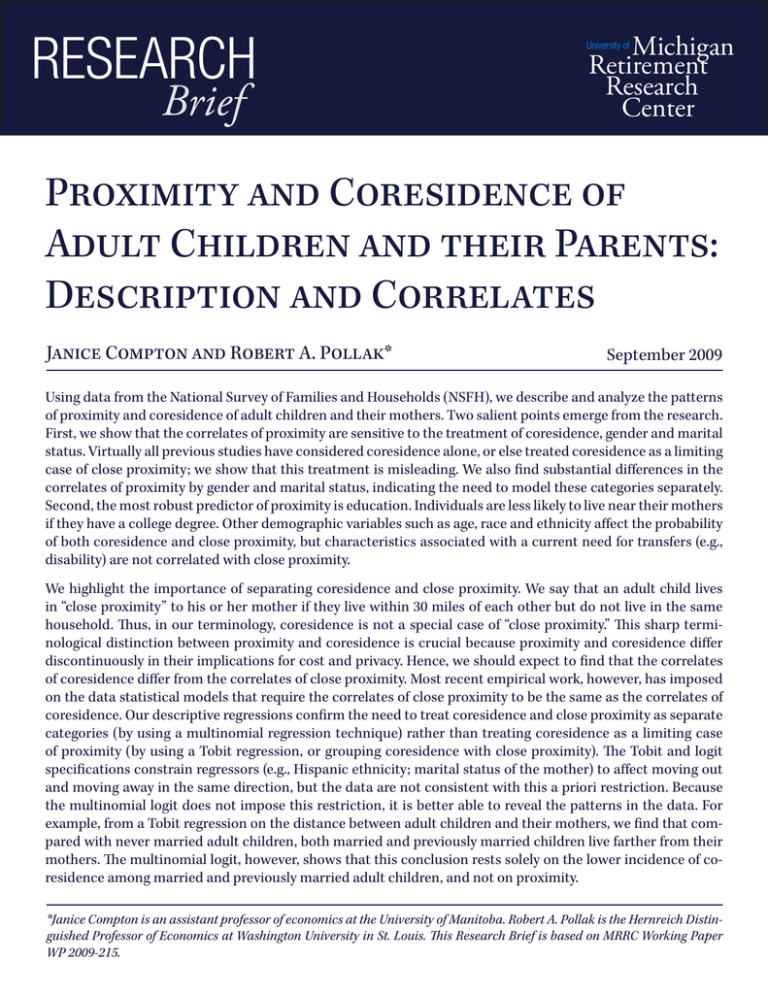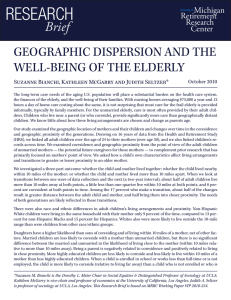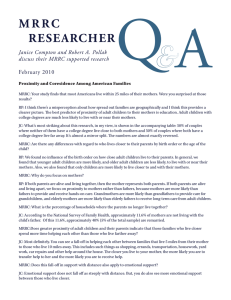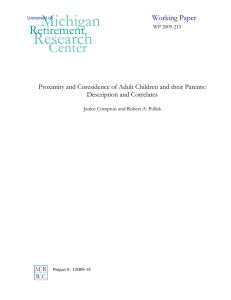ReseaRch Brief Proximity and Coresidence of Adult Children and their Parents:
advertisement

ReseaRch Brief Michigan Retirement Research Center University of Proximity and Coresidence of Adult Children and their Parents: Description and Correlates Janice Compton and Robert A. Pollak* September 2009 Using data from the National Survey of Families and Households (NSFH), we describe and analyze the patterns of proximity and coresidence of adult children and their mothers. Two salient points emerge from the research. First, we show that the correlates of proximity are sensitive to the treatment of coresidence, gender and marital status. Virtually all previous studies have considered coresidence alone, or else treated coresidence as a limiting case of close proximity; we show that this treatment is misleading. We also find substantial differences in the correlates of proximity by gender and marital status, indicating the need to model these categories separately. Second, the most robust predictor of proximity is education. Individuals are less likely to live near their mothers if they have a college degree. Other demographic variables such as age, race and ethnicity affect the probability of both coresidence and close proximity, but characteristics associated with a current need for transfers (e.g., disability) are not correlated with close proximity. We highlight the importance of separating coresidence and close proximity. We say that an adult child lives in “close proximity” to his or her mother if they live within 30 miles of each other but do not live in the same household. Thus, in our terminology, coresidence is not a special case of “close proximity.” This sharp terminological distinction between proximity and coresidence is crucial because proximity and coresidence differ discontinuously in their implications for cost and privacy. Hence, we should expect to find that the correlates of coresidence differ from the correlates of close proximity. Most recent empirical work, however, has imposed on the data statistical models that require the correlates of close proximity to be the same as the correlates of coresidence. Our descriptive regressions confirm the need to treat coresidence and close proximity as separate categories (by using a multinomial regression technique) rather than treating coresidence as a limiting case of proximity (by using a Tobit regression, or grouping coresidence with close proximity). The Tobit and logit specifications constrain regressors (e.g., Hispanic ethnicity; marital status of the mother) to affect moving out and moving away in the same direction, but the data are not consistent with this a priori restriction. Because the multinomial logit does not impose this restriction, it is better able to reveal the patterns in the data. For example, from a Tobit regression on the distance between adult children and their mothers, we find that compared with never married adult children, both married and previously married children live farther from their mothers. The multinomial logit, however, shows that this conclusion rests solely on the lower incidence of coresidence among married and previously married adult children, and not on proximity. *Janice Compton is an assistant professor of economics at the University of Manitoba. Robert A. Pollak is the Hernreich Distinguished Professor of Economics at Washington University in St. Louis. This Research Brief is based on MRRC Working Paper WP 2009-215. We treat separately married and unmarried adult children for both theoretical and empirical reasons. Theory suggests that migration and location decisions of married adult children are taken jointly with spouses whose preferred locations may differ from theirs because of career or family considerations. Furthermore, with increasing age at marriage and high geographical mobility before marriage (e.g., going away to college), mothers and mothers-in-law are less likely to live near each other. The need to distinguish between married and unmarried adult children is underscored by our findings about the proximity of women and their mothers. Pooling all adult children and controlling for marital status, we find no effect of gender on proximity or coresidence. When we separate the sample by marital status, however, we find that gender is a strong correlate of coresidence: married women are more likely than married men to live with their mothers, unmarried women are less likely than unmarried men to live with their mothers. Most adult Americans live very close to their mothers, with large differences across education groups. For all married couples, the median distance from his mother is 25 miles and the median distance from her mother is 20 miles. Forty percent of all couples live close to (within 30 miles of) both mothers, and 30 percent live close to one mother.1 Education plays a crucial role: we find that only 18 percent of power couples (couples in which both spouses hold a college degree) live close to both mothers, while 50 percent of low-power couples (couples in which neither spouse holds a college degree) live close to both mothers. At the opposite extreme, almost half of power couples live far from both mothers, while only one-fifth of low-power couples live far from both mothers. In our regression analyses, educational attainment is the most consistent correlate of close proximity of the adult children to their mothers. Adult children with college degrees are much less likely to live near or with their mothers. This may be true for at least four reasons. First, young adults may leave home to attend college and not return. Second, college educated couples are less likely to come from the same state; without a common home state, they are more likely to live far from both mothers. Third, the college educated may participate in a geographically wider labor market and, therefore, are more likely to move away for employment. Finally, if college educated adult children are more successful in employment and earnings, time transfers from mothers may be less important to them. We find little evidence that patterns of proximity are related to current need for intergenerational transfers of care. We find no evidence that close proximity or coresidence is correlated with the presence of young children. Although unmarried mothers are more likely to live in close proximity to their adult children, most other mothers’ characteristics that would suggest a greater need for intergenerational transfers are not related to close proximity. In contrast to proximity, coresidence is strongly related to mother’s characteristics, with a strong gender pattern: women, both married and unmarried, are more likely to live with older mothers (aged 75 and over); married men are less likely to live near older mothers, and unmarried adult men, the group most likely to live with their mothers, are less likely to live with mothers in poor health. 1 These figures are based on the sample of couples for whom both mothers are alive and living in the United States. University of Michigan Retirement Research Center Institute for Social Research 426 Thompson Street Room 3026 Ann Arbor, MI 48104-2321 Phone: (734) 615-0422 Fax: (734) 615-2180 mrrc@isr.umich.edu www.mrrc.isr.umich.edu The research reported herein was performed pursuant to a grant from the U.S. Social Security administration (SSA) through the Michigan Retirement Research Center (MRRC). The findings and conclusions expressed are solely those of the author(s) and do not represent the views of SSA, any agency of the federal government, or the MRRC. Regents of the University of Michigan: Julia Donovan Darlow, Laurence B. Deitch, Denise Ilitch, Olivia P. Maynard, Andrea Fischer Newman, Andrew C. Richner, S. Martin Taylor, Katherine E. White, Mary Sue Coleman, Ex Officio








